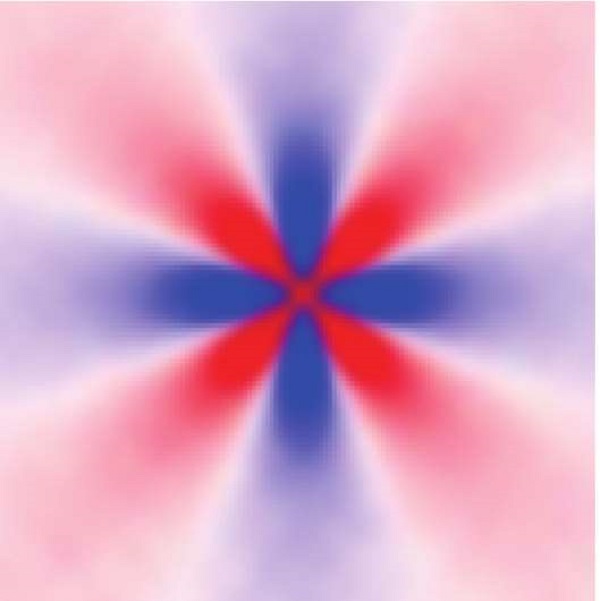New key feature found in amorphous materials Correlation between points remains intact, even over a long distance


Spatial correlation of elastic stiffness of a two-dimensional amorphous solid in the wave number space
The red color represents the positive, and the blue color represents the negative spatial correlation of the elastic stiffness. The result indicates that the spatial correlation decays in proportion to the inverse of the square of distance.
© 2016 Hajime Tanaka.
A research group at the University of Tokyo and their collaborators have successfully revealed through simulations that spatial fluctuations of the hardness in amorphous solids, which do not have a regular ordered structure like crystals, are not independent but correlated even between faraway points. Such long-range correlations may be the key feature that sets the two materials apart.
It is common scientific knowledge that amorphous and crystalline solids manifest vastly different physical properties at low temperature. These properties include the ability to conduct heat; heat capacity, or the amount of energy needed to raise the temperature of the material; and the behavior of energy from vibrations. The physical origin of these differences is a long-standing mystery recognized as one of the greatest unsolved problems in condensed matter physics. In solids, atoms cannot be made to vibrate on their own as they are effectively connected by springs, thus creating coherent oscillations, called phonons, around their stable positions. Disturbance within the structure of amorphous solids is known to cause varying degrees of hardness in different locations of the material, with the scattering of the phonons significantly affecting the material’s physical properties. However, such variation in hardness, known as elastic fluctuation, was thought to occur only locally.
The research group of Professor Hajime Tanaka of the Institute of Industrial Science at the University of Tokyo and their international collaborators successfully revealed, through simulations, that elastic fluctuations in fact exhibit correlation over a long distance—contrary to what scientists assumed to be true until now—resulting in stronger scattering of long-wavelength phonons. The current finding strongly suggests that to understand the difference between amorphous and crystalline solids requires recognizing that two points, rather than acting independently, communicate over a long distance in amorphous solids to maintain an equilibrium of forces.
“Unlike liquids, the positions of atoms in both amorphous and crystalline solids are determined by the balance of forces acting on atoms and, thus, the atoms do not move much. Due to this constraint, the internal stress and stiffness of the solid cannot fluctuate independently in the presence of structural disorder, even over a long distance,” says Tanaka. He continues, “Although this fact may seem obvious once we have the knowledge, it had been overlooked for a long time. We expect that recognizing it will contribute to a deeper understanding of the properties of amorphous solids.”
The research outcome is the result of a collaboration with a team at the Laboratoire Navier in France.
Paper
, "Anomalous phonon scattering and elastic correlations in amorphous solids", Nature Materials (2016) Online Edition: 2016/08/30 (Japan time), doi: 10.1038/nmat4736.
Article link (Publication)
Links
Institute of Industrial Science
Department of Applied Physics, Graduate School of Engineering
Laboratory of Hajime Tanaka, Institute of Industrial Science






